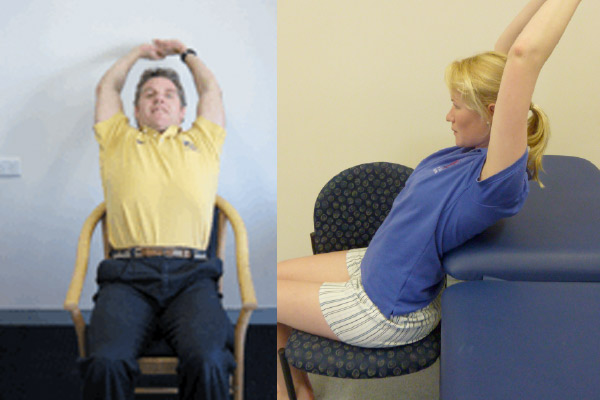Goalies: 6 Surprisingly Easy Stretches to Avoid Injuries
Goalies or goalkeepers, are the last line of defence in a team and, arguably the most important player on the field. Or at least they take the brunt of the blame after conceding a goal.
A goal keeper’s fitness and skill requirements vary greatly to the other players on the field, and as a result your training should differ also!
Currently, there are very little resources for goal keepers to follow in order to optimize their training time. This often makes it difficult to complete an individual program when you’re a part of a team.
This article will discuss targeted training options that you could complete at the same time as the rest of your team. Then you’ll be in tip-top shape for the rest of the season.
Firstly, let’s look at the different types of sports where you’ll find goalkeepers.
Field Hockey
Field hockey is played in more than 100 countries and is in the top 5 of the most popular team sports of the world. It has recently been estimated that up to 20% of hockey players experience an injury in a single season.
This results in sub-optimal performance and often leads to re-injury. These injuries include fractures and wounds due to being struck by a stick or ball. However, the majority are sprains and strains of the lower limb for field players. And, both the lower and upper limbs in goal keepers.
The Goal Keeper
The goalie is the last of the 11 members of a hockey team and your skills, equipment and even rules vary to every other team member. The goal keeper also wears much more protective equipment than a field player.
This protective equipment is vital for your safety but can also weigh anywhere between 5-10kg. This is a lot of weight to be carrying around for 70 minutes. Let alone while performing explosive movements, diving on the ground and sprinting short distances!
By working on your explosive power and anaerobic fitness, you will be able to handle this weight and the requirements of a goal keeper throughout a game.
Equipment:
- Helmet
- Throat protector
- Chest Protector
- Arm Guards
- Gloves
- Pelvic Protector
- Padded Shorts
- Kickers
- Leg Guards
- Stick
Ice Hockey
Although not as popular in Australia as field hockey, ice hockey is one of the most popular team sports in the United States and Canada. Ice hockey also ranks as the fastest team sport in the world, with the players skating up to 60km/hr on the rink. This, as well as the fact that ice hockey is a collision based sport, obviously exposes the players to an increased risk of injury.
Fortunately, ice hockey rules have recently been developed to include a protective rule for the goalies . This means field players are penalised if they make any heavy contact with goal keeper. The highest reported injuries in ice hockey are lacerations, usually from the skates during collisions, however this is closely followed by contusions, sprains and fractures.
The Goal Keeper
Ice hockey goalkeepers are usually referred to as goal tenders, and like any other sports are the last line of defence in the team. In ice hockey, the goal cage itself is almost half the size smaller than that of a field hockey goal. This means your fitness and skill requirements differ slightly; reaction time and flexibility are paramount, whereas agility and explosive power are not near as important as you don’t need to throw your body around as much.
However, an ice hockey puck usually reaches speeds of 130-170km/hr whereas a field hockey ball usually only reaches 80-100km/hr. Therefore, the goal tender in ice hockey requires more protective equipment, which weighs between 18-22kg!
Equipment:
- Mask
- Chest Protector
- Arm Protectors
- Catcher Glove
- Blocker Glove
- Pants/breezers
- Jockstrap
- Leg pads
- Skates
- Stick
Football / Soccer
Soccer or Football is currently ranked as the worlds most popular team sport and is considered one of the three most popular in Australia. According to recent studies the incidence of injuries for soccer players is 8 injuries for every 1000 hours of playing. Of these injuries sprains and strains were the highest occurring, followed by overuse injuries as well as fractures and contusions.
We’ve written in the past about preventing knee injuries for female soccer players and well how to reduce injuries for soccer players.
The Goal Keeper
Soccer goal keepers, as per field and ice hockey keepers are designated the role of protecting the goal of their team. A soccer goal keeper however, differs quite substantially to both hockey goal keepers. Firstly, as a goal keeper in soccer, you are required to protect a much larger goal; double the length and a foot higher than that of a field hockey goal; meaning that agility and explosive power are vitally important, as well as reaction time, flexibility and speed. To allow this task to become a little more achievable, soccer keepers wear much less protective equipment as they don’t require as much protection from the softer, larger soccer ball.
Why Goalkeepers Get Injured
Goal keepers place their body in highly demanding positions when reacting to a shot numerous times throughout a game, therefore your flexibility and reaction time becomes crucial in these circumstances to:
- Save the goal; and
- Prevent injury
Flexibility is disputably the most essential attribute for a goal keeper to have and maintain throughout a season. It is a key component to developing neuromuscular efficiency and maintaining equilibrium within the body. Athletes require full length of all muscles as well as optimum control of movements in all directions (i.e. coordination) to allow for the safe full range of motion at any joint. If this isn’t occurring the joint and associated muscles will be placed under loads that they can’t tolerate which will ultimately lead to injury. Below we will discuss some of the most common injuries experienced by goal keepers and their associated symptoms, as well as the best stretches to decrease the likelihood of these injuries.
You might be interested in the FIFA 11+ . This is a complete warm-up and injury prevention program for amateur players. (Click here to download the PDF).
Common Goal Keeping Injuries
As we have already discussed, goal keepers experience vastly different injuries to all other members of the team due to the different requirements of their positions. Due to the level of protective equipment goal keepers are far less prone to suffering injuries from being struck with a stick or ball but are still as prone to acute and overuse injuries as their fellow team mates.
The most common injuries (being muscle strains) usually occur from the rapid contracting and lengthening of muscles as the goal keeper reacts to save a shot. Of course, other injuries still occur to the goal keeper and the most common are outlined below.
If you are experiencing any of the signs and symptoms of the common injuries below and want to be in peak shape for the season, it’s best to get on top of things early with specific exercises (some of the best stretches are outlined below) that can be prescribed by your physiotherapist.
1. Muscle Strain
A strained muscle, a pulled muscle or more commonly known, a muscle tear refers to varying levels of damage and destruction that can occur to a muscle and can be graded on this severity. This usually occurs after a traumatic or strenuous event such as sprinting, suddenly changing direction, heavy lifting or throwing but can also occur during innocuous activities that we perform every day.
This type of injury can happen to any muscle of the body, but among goal keepers the most common are the hamstrings, adductors and quadriceps due to the rapid contraction of these with quick explosive movements.
Signs and Symptoms:
- Pain at the site of the strain
- Inability to use the muscle
- Bruising to the area
- Swelling to the area
2. Ligament Sprain
Ligaments are bands of strong connective tissue that surround a joint and provide it with movement, as well as stability. Like a muscle strain, ligament sprains vary in the level of damage and also work on a similar grading system. A sprain can also occur to any joint of the body and is one of the most common injuries amongst team sports for soccer goal keepers the most common joint for ligament damage to occur is the ankle, while for field and ice hockey keepers its’ the knee, as well as the acromioclavicular joint which is located between collar bone and acromion in your shoulder.
Signs and Symptoms:
The signs and symptoms obviously vary depending on the severity of the damage but the following is a guideline to what occurs after ligament damage:
- Pain to the area of damage
- Swelling, from mild to large
- Bruising may or may not be present
- Limited ability to use the joint
- You may or may not hear a “pop” at the time of the injury
3. Overuse Injuries
Overuse injuries occur from repetitive stress or trauma placed on a joint, tendon, muscle or bone and like any injury can occur anywhere in the body. However, the most common overuse injuries amongst goalkeepers occur in the ankles, knees and shoulders. The most common of these being:
- Achilles Tendinopathy
- Plantar fasciitis
- Patellofemoral Pain
- Patella Tendinopathy
- Rotator Cuff Tendinopathies with or without subacromial bursitis
For the best rehabilitation of overuse injuries it is best to get on top things early, as the longer it progresses the longer recovery takes. Initially your pain may disappear after warming up but this generally indicates the early stages of an overuse injury; therefore it is best to get this checked out straight away!
Signs and Symptoms:
- Pain in the area
- Decreased ability to use the join tor muscle
- Swelling
- Redness
- Stiffness
6 Surprisingly Easy Stretches for the Prevention of Injuries
Obviously prevention is better than treatment, so outlined below are the best stretches for goal keepers to perform in order to decrease your risk of injury and to keep you in top shape.
Warning: Start all exercises gently and increase intensity gradually
1. Butterfly Stretch for Goalies
Sit on the ground. Put your legs out to the side with your knees bent and the soles of your feet together. Keep your back straight put your elbows on your thighs or your knees and push towards the ground with your forearms.
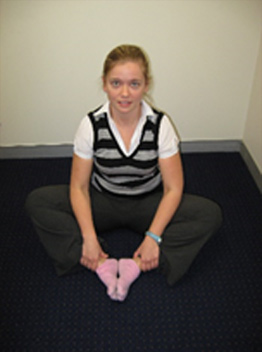
2. Hamstring Stretch for Goalies
With Towel – Lie flat on the floor and loop a towel around one foot. Keeping your foot pointed back and your leg straight, pull the towel towards you until you feel a stretch up the back of your thigh.
On chair – Stand in front of a chair and place your foot on the chair, keeping your leg straight and your toes pulled back towards you. On your standing leg, point your toes in. Keeping your back straight and pelvis level, place your hands on the outside of your leg and lean forwards towards the outside of your knee.
Against wall – Lie down flat next to a door with your bottom up against the wall. Lift your leg up and lay it on the wall, keeping your knee straight and foot pulled back towards you and hold for 5-10 minutes
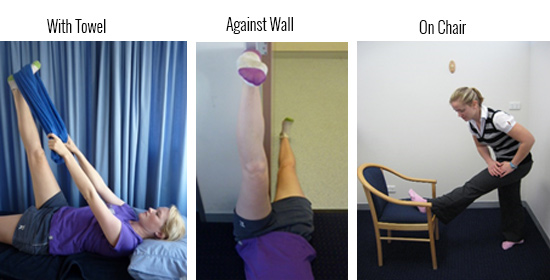
3. Long Groin Stretch for Goalies
Lift your leg out to the side onto the table and point your toes. Make sure the foot on the ground is pointing straight forward. Slide the leg on the table out away from your body, without bending your trunk forwards.
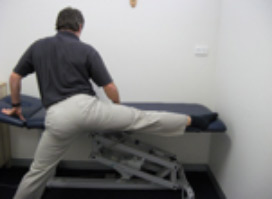
4. Hip Flexor / ITB Stretch for Goalies
Place your toes on the chair and your knee on the pillow. Put your other foot out in front with your knee bent to 90° and in line with the knee on the pillow.
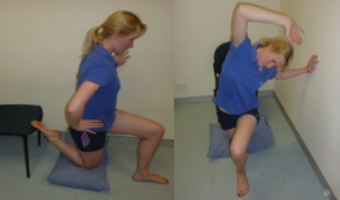
5. Stop Sign for Goalies
Place your hand on the doorframe so that your elbow is slightly higher than your shoulder and your elbow is away from the doorframe. Step forwards with the same leg as the arm you are stretching. Avoid rotating your trunk. Push your chest forwards until you feel a gentle stretch at the front of your shoulder.
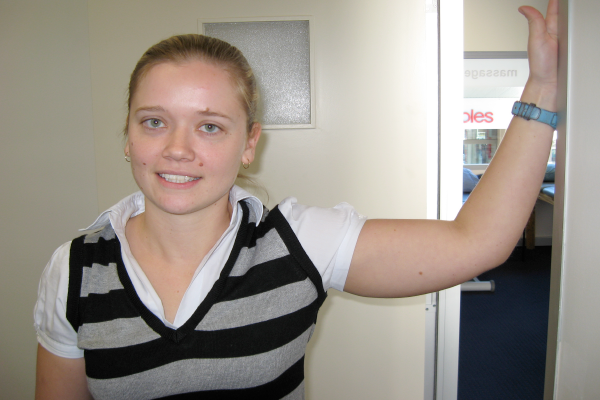
6. Thoracic Extension for Goalies
Sit in a chair or against the edge of a desk, with your feet flat on floor. Clasp your hands together and place them above your head. Lean backwards over the back of the chair. Keep your head looking forward.
